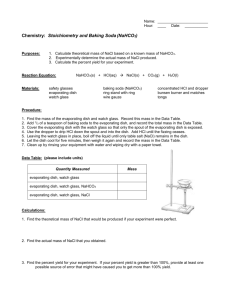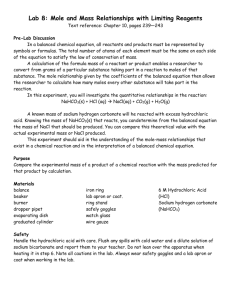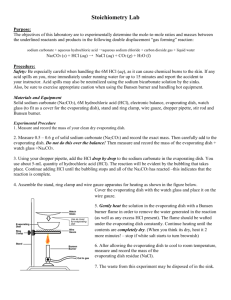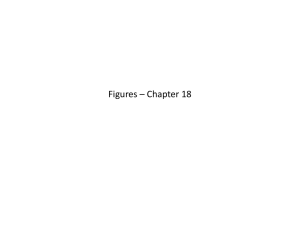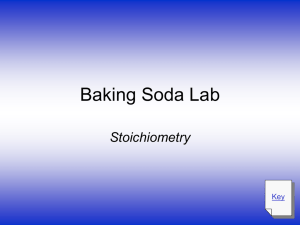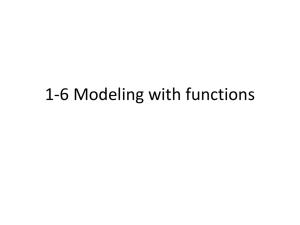chem sodium bicarbonate lab
advertisement
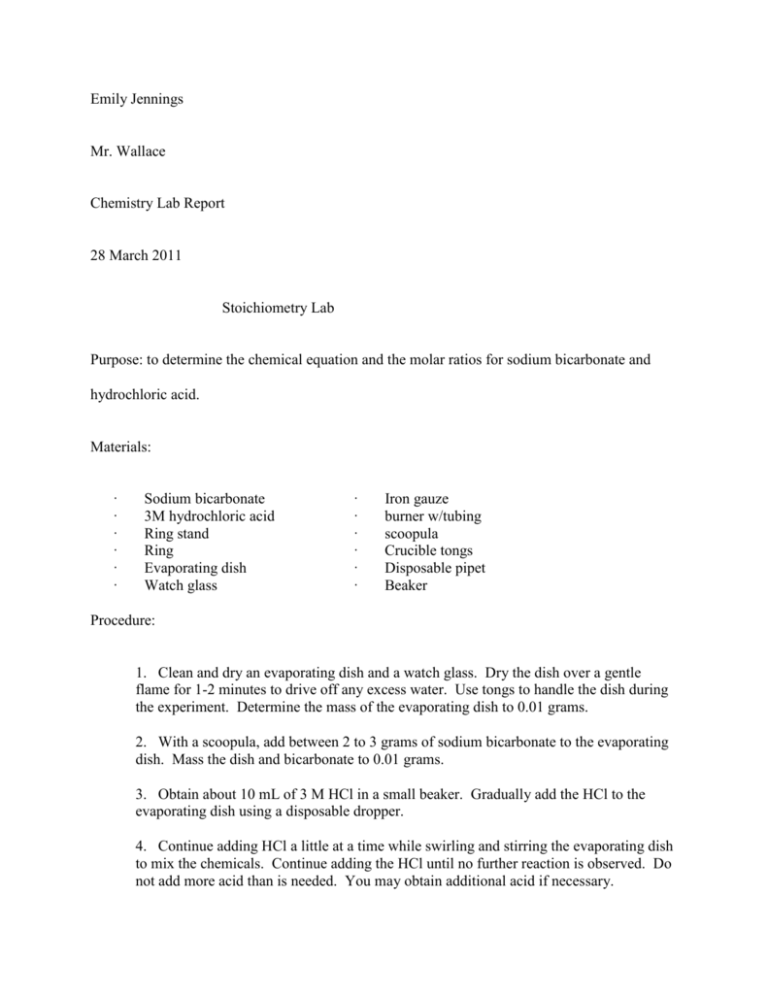
Emily Jennings Mr. Wallace Chemistry Lab Report 28 March 2011 Stoichiometry Lab Purpose: to determine the chemical equation and the molar ratios for sodium bicarbonate and hydrochloric acid. Materials: · · · · · · Sodium bicarbonate 3M hydrochloric acid Ring stand Ring Evaporating dish Watch glass · · · · · · Iron gauze burner w/tubing scoopula Crucible tongs Disposable pipet Beaker Procedure: 1. Clean and dry an evaporating dish and a watch glass. Dry the dish over a gentle flame for 1-2 minutes to drive off any excess water. Use tongs to handle the dish during the experiment. Determine the mass of the evaporating dish to 0.01 grams. 2. With a scoopula, add between 2 to 3 grams of sodium bicarbonate to the evaporating dish. Mass the dish and bicarbonate to 0.01 grams. 3. Obtain about 10 mL of 3 M HCl in a small beaker. Gradually add the HCl to the evaporating dish using a disposable dropper. 4. Continue adding HCl a little at a time while swirling and stirring the evaporating dish to mix the chemicals. Continue adding the HCl until no further reaction is observed. Do not add more acid than is needed. You may obtain additional acid if necessary. 5. Set up the ring stand with the ring and wire gauze. Place the evaporating dish on the wire gauze and start heating gently. After 2-3 minutes, increase the flame to boil the liquids away while keeping the watch glass over the dish. Be careful that it doesn’t boil over. 6. As the reaction products become dry, there will be a tendency for the product to spit particles from the crucible. Take care to keep the watch glass over the evaporating dish to minimize any loss of product. 7. When the product is dry, remove the evaporating dish from the heat. If any product has stuck to the watch glass, scrape it back into the dish with a Scoopula or wash it back into the evaporating dish with deionized water and dry further. 8. When all liquids are evaporated, allow the evaporating dish to cool and determine its mass. To the nearest 0.01 grams. 9. Put the evaporating dish back on the heat for a final drying cycle, cool, and then mass again to the nearest 0.01 grams. The two masses should be within 0.02 grams. If not, return for another drying cycle. Data Analysis: Material Amount Mass of evaporating dish 46. 64 g Mass of evaporating dish + sodium bicarbonate 48.59 g Mass of sodium bicarbonate 2.95 g Molar mass of sodium bicarbonate 104.07 g/mole Moles of sodium bicarbonate 0.03 moles Mass of evaporating dish + product 48.56 g Mass of product 1.92 g Molar mass of product 58.44 g NaCl/ mole Moles of product .03285 moles % yield = 2.95 g 1mole mole NaHCO3 = 2.05 g NaCl (theoretical) 1.92/2.05 x 100 = 93.655 yield % Error: exp – accepted/ accepted x 100 1.92-2.05/2.05 x 100 = 6.34% Balanced Equation: mole NaHCO3 84.01 g NaHCO3 58.44 g NaCl 1 mole NaCl NaHCO3+HCL -à NaCl+H2O+C02 Sodium bicarbonate is a chemical compound with the formula NaCHO3. Is has a white solid that is crystalline but appears as fine powder. It has a salty taste to it and is dissolved into many mineral springs. It has come to be known by many different names and is used in various ways such as baking soda, cooking soda and bread soda. Sodium bicarbonate is not only a baking ingredient but used in other ways as well. Sodium bicarbonate is and antacid used to relieve heartburn as well as indigestion. This comes in a tablet as well as powder that you take by mouth. This is a pill necessary by prescription. An overdose of sodium bicarbonate can also be harmful to your body so it is necessary to maintain a healthy balance.
